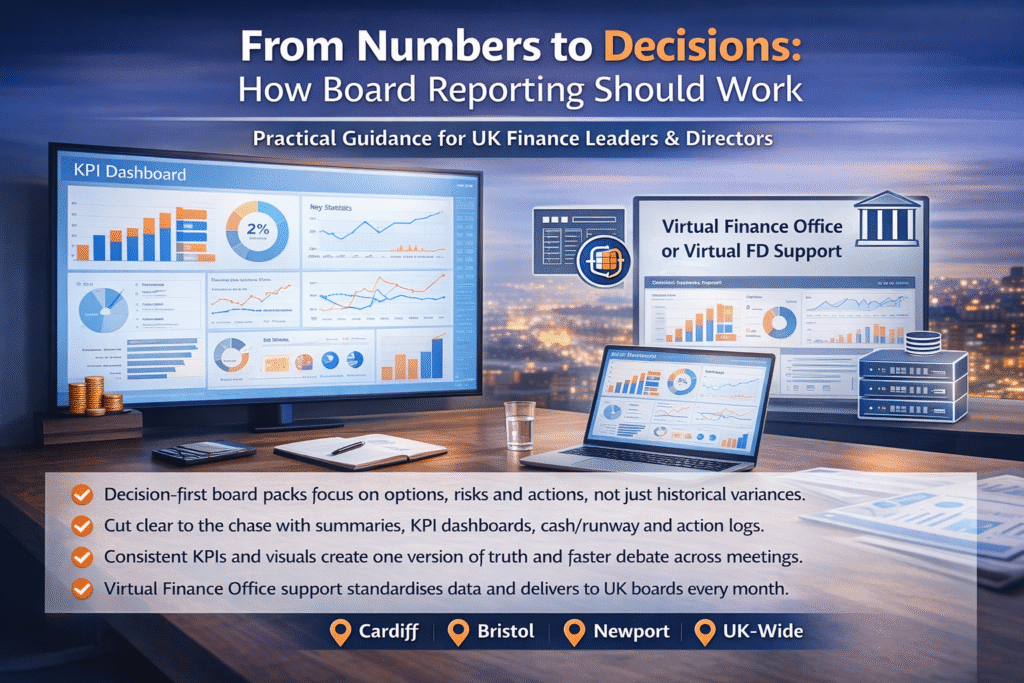We offer a systematic & strategic approach to optimise your business cash flow with a 13-week plan, supported by our fractional finance director.
- Promise: 13 weeks = one quarter of foresight and decisive control.
- Outcome: predictable runway, fewer cash shocks, credible board and lender updates.
- Method: rolling forecast + weekly variance analysis + action log + short cash huddle led by a VFD / Fractional CFO.
Key takeaways
- Run weekly, not weakly. A 13-week cash flow uses receipts vs disbursements in weekly buckets so you always know cash runway, headroom, and covenant outlook.
- Assign owners, not excuses. Give clear ownership to AR (collections), AP (payment runs), Payroll, VAT/taxes, Capex, and Debt service. Accountability fixes accuracy.
- Measure accuracy, drive action. Track forecast accuracy %, variance reduction, DSO/DPO, and weeks of runway; publish a weekly cash action log.
- Keep it rolling. Each week, add one future week to stay at 13 weeks ahead. Build scenarios and stress tests for shocks.
- Make governance a habit. Hold a 30-minute cash huddle chaired by your VFD / Fractional CFO. Confirm updates, agree actions, and escalate blockers.
- Pull the levers that move money. Improve collections, extend supplier terms, tidy inventory, adjust revenue timing, and manage treasury rules.
- Connect short term to strategy. Feed the 13-week view into budgeting, fundraising readiness, scenario planning, and management accounts so finance and operations row together.
- Start with what you have. Begin with opening bank, AR ageing, AP due, payroll dates, VAT/tax, and loans. Refine weekly with variance learning under a Part-Time CFO.
Common Questions
How is a 13-week cash flow different from a monthly budget?
A 13-week cash flow is a weekly cash forecast of receipts and disbursements; a budget is a monthly profit plan (P&L). Use the 13-week tool for liquidity, runway, and covenant headroom; use the budget for profit, margin, and cost control. A Fractional CFO syncs both so cash reality informs profit plans.
What’s the minimum data needed to start?
You need opening bank balance, AR ageing with promised dates, AP due list, payroll calendar, VAT/tax dates, debt service, and capex commitments. Add FX exposure and intercompany flows if relevant. A VFD improves precision from Week 2 with variance analysis.
How accurate should the forecast be after a few weeks?
Aim for ±5–10% on total weekly cash by Week 6. Accuracy improves when line owners update on time, when cut-offs are enforced, and when recurring errors found in the variance review are fixed by your Part-Time CFO.
Can I automate the 13-week forecast with Xero/QuickBooks/Sage?
Yes. Pull AR, AP, bank feeds, and payroll automatically. Then layer manual timing adjustments, collections cadence, supplier negotiations, and one-off items. Automation speeds updates; a VFD safeguards governance and treasury controls.
How does a VFD / Fractional CFO keep AR/AP owners accountable weekly?
With a tight cash huddle, a visible RACI, a live action log, and variance sign-offs. The VFD escalates missed actions, resets assumptions, and keeps cash stewardship front and centre for the CEO and board.
What happens after Week 13—do we restart?
No. You roll forward. Each week you drop last week’s actuals, shift the horizon, and add a new week to keep 13 weeks ahead. You re-baseline assumptions and update the board/lender pack.
Learn: Why your business may starve for cash while staying profitable!

What exactly is a 13-week cash flow—and why 13 weeks?
A 13-week cash flow is a rolling, weekly forecast that covers the next thirteen weeks—about a quarter. It projects cash in (customer receipts, deposits, grants) and cash out (suppliers, payroll, taxes, interest, capex). It shows where the cash runway tightens, where headroom may breach, and which working capital levers to pull. It is the core treasury management tool for an SME when run by a Virtual Finance Director / Fractional CFO.
Why weekly? Because payroll lands on set days, suppliers are paid in batches, VAT hits quarterly, and sales cycles turn with seasonality. Weekly buckets capture the timing that monthly budgets blur.
Why 13 weeks?
- It aligns with board and lender reporting cadence.
- It gives time to renegotiate supplier terms, run an AR campaign, and adjust inventory, yet it stays accurate.
- It matches common covenant windows and facility reviews, improving lender trust.
What are the steps to set up the 13-week model correctly?
Get the structure right once; updates then take minutes under a Part-Time CFO.
Inputs (single sources of truth)
- Accounts Receivable (AR): ageing, promised dates, disputes, credit holds.
- Accounts Payable (AP): due dates, critical vendors, early-payment discounts, term options.
- Payroll: dates, gross-to-net, pensions, commissions, bonuses.
- Taxes: VAT, PAYE, Corporation Tax, duties; filing calendars.
- Capex & projects: committed spend, stage payments, delivery schedules.
- Debt service: principal, interest, revolving facility usage, covenants and headroom.
- Other: FX exposure, intercompany cash pooling, insurance premia, grants.
Model logic (the forecasting engine)
- Receipts schedule: apply DSO and promised dates with probability weights; tag key debtors.
- Disbursements schedule: apply DPO, approval workflow, and realistic payment runs; tag critical suppliers.
- Cash ladder: opening bank → net weekly cash → closing bank.
- Runway & headroom: compare closing cash to minimum cash and to facility limits/covenants.
- Scenarios: sales slip, debtor default, VAT delay, FX swing, one-off costs.
Outputs (decision views)
- Liquidity dashboard: closing cash per week, headroom trend, breach alerts.
- Covenant outlook: leverage/interest cover proxies, borrowing-base impacts.
- Action list: collections priorities, supplier moves, spend deferrals.
- Board/lender pack: one-page story, bridge charts, risk log, mitigation plan.
How does the weekly operating cadence work across 13 weeks?
The power is the cadence—the same routine every week, enforced by your VFD / Fractional CFO with owners who update on time.
Week 1 — Build the base and load opening balances
Set opening bank, define minimum cash, map AR/AP and payroll. Categorise inflows/outflows; protect formulas; tag line owners. Publish Version 1 and schedule the weekly cash huddle.
Week 2 — First forecast-vs-actual variance review
Compare Week 1 actuals with Week 1 forecast. Explain timing variances; correct assumptions. Confirm RACI and add actions (e.g., call top-five debtors; confirm supplier dates).
Week 3 — Collections cadence begins
Run structured dunning (emails, calls, statements). Offer early settlement if ROI is strong. Record promises-to-pay in the receipts schedule; start shifting DSO.
Week 4 — Supplier prioritisation with governance
Hold a supplier prioritisation meeting. Protect payroll, taxes, and critical vendors; re-time non-critical items; communicate realistic dates. Align AP with headroom and covenants.
Week 5 — Payroll & VAT stress-test
Validate payroll and VAT against projected headroom. If tight, accelerate AR, phase discretionary spend, or pre-draw facilities. A Part-Time CFO leads the trade-offs.
Week 6 — Forecast accuracy check and recalibration
Measure forecast accuracy % for receipts and disbursements. Fix bias (over-optimistic AR, under-estimated freight). Embed scenario analysis (base/best/worst).
Week 7 — Management report and covenant watch
Publish liquidity KPI dashboard: weeks of runway, headroom, covenant monitoring. Log risks with owners and due dates. The VFD signs off and circulates to leadership.
Week 8 — Supplier renegotiation cycle
Use data to request extended terms or dynamic discounting. Update DPO assumptions and payment schedules. Track supplier health to protect supply chain.
Week 9 — AR campaign
Target top-ten debtors; resolve disputes; tighten credit control. Update promises, adjust weights, track promised-to-cash conversion.
Week 10 — Board/lender pack presentation
Deliver a concise board/lender pack: runway, headroom, risks, mitigations. Add accuracy trend and action log. Seek approvals if needed (facility tweaks, term extensions). A Fractional CFO is a credible voice in that room.
Week 11 — Seasonality and FX overlay
Adjust for holidays, shipment cycles, and FX. Set near-term hedge or conversion policy where material. Annotate drivers for non-finance readers.
Week 12 — Sensitivity analysis
Test 10% sales slip, debtor default, VAT delay, freight spike. Mark breach points; agree trigger-based actions with Ops and Sales.
Week 13 — Quarter review, lessons, re-baseline
Run full variance analysis. Document shifts in DSO, DPO, inventory, and spend controls. Re-baseline assumptions; add the new Week 13; repeat.
Invariant rhythm each week: update the forecast → review variances → publish action log → 30-minute cash huddle.
Follow this cash collection playbook to make your cash flow better.

How does a VFD / Fractional CFO enforce accountability?
A seasoned Virtual Finance Director (or Part-Time CFO) turns a spreadsheet into a management system.
- Cash huddle (30 minutes): time-boxed agenda—actuals, variance, actions, risks, decisions.
- RACI & line ownership: AR owns collections; AP owns payment runs; Payroll owns dates; Tax owns filings; VFD owns the master file and governance.
- Spend control policy: thresholds for approvals, PO discipline, capex gates; treasury policy for payments and bank access.
- Escalation rules: missed actions escalate to the CEO; recurring misses drive process changes.
- Documentation: action log, variance memos, board pack, lender update, covenant watchlist.
- Culture: visible dashboards, short cycle-times, “no surprises” reporting.
Which working-capital levers move the dial in thirteen weeks?
Cash moves when you pull levers with intent and measure the effect.
Accounts Receivable (AR)
- Collections cadence: weekly calls, email sequences, statements, SMS nudges where appropriate.
- Debtor prioritisation: focus on large/late accounts; escalate disputes early; apply credit control rules.
- Invoice quality: accurate, complete, and sent early to shrink disputes.
- Financing options: invoice discounting or selective receivables finance when cost < benefit.
Accounts Payable (AP)
- Term negotiations: extend where strategic; agree realistic schedules; protect supply.
- Payment run design: weekly runs aligned to cash headroom.
- Dynamic discounting: earn safe returns by early payment on predictable suppliers.
Inventory
- Stock reduction: trim slow movers; set realistic safety stock.
- Just-in-time: where feasible for non-critical SKUs.
- Disposition plans: clear obsolete items; free cash and space.
Revenue timing
- Milestone billing & deposits: invoice earlier where contracts allow.
- Progress billing: tie invoices to delivery stages; reduce WIP drag.
- Cash-for-value trade-offs: manage discounts like investments with clear ROI.
How does the 13-week discipline connect to wider CFO/VFD services?
The 13-week engine is the operational core of a Virtual Finance Director / Fractional CFO offering.
- Budgeting & planning: weekly insight flows into the annual plan and quarterly re-forecasts; profit plans anchored to cash reality.
- Scenario modelling: sensitivities become formal scenarios for pricing, hiring, capex, and funding.
- Fundraising readiness: lenders and investors back companies that prove accuracy, headroom control, and governance with a 13-week track record.
- Management accounts: cash view reconciled to P&L, balance sheet, and working capital for one truth.
- Treasury oversight: payment policies, banking arrangements, signatory frameworks, fraud controls.
When should you book a 15-minute call with a Virtual Finance Director / Part-Time CFO?
Book when the pressure is visible—or before growth outpaces systems.
- Lumpy cash and nail-biting payroll weeks.
- VAT pinch points or missed filings.
- Lender scrutiny and covenant worries.
- Rapid growth without a collections or AP strategy.
- Seasonality/FX causing late surprises.
- New facility negotiations where evidence of discipline wins terms.
Book your free 15-minute Fractional CFO call.
Get a ready-to-use 13-week template, a checklist, and a governance cadence to start Week 1 now.

What keeps admin low and accuracy high?
Reduce admin by automating the data and standardising the routine, then spend human time on decisions—guided by your VFD.
- Automation: integrate Xero/QuickBooks/Sage for AR/AP, bank feeds, payroll journals.
- Cut-off discipline: Tuesday noon owner updates; Wednesday cash huddle; lock the file post-meeting.
- Variance memos: two lines per variance—cause and countermeasure.
- Template hygiene: inputs on clearly labelled tabs; formulas protected; weekly versions saved.
- Controls: PO thresholds, capex approvals, dual-authorised payments, supplier masterfile integrity.
- Data dictionary: consistent definitions for “received”, “paid”, “approved”, “committed”.
What goes in a strong 13-week board/lender pack?
Keep it short, visual, and repeatable—your Part-Time CFO curates the essentials.
- Runway & headroom: closing cash by week; facility usage; breach alerts.
- Covenant outlook: leverage/interest cover proxies; buffer markers; stress results.
- Bridge charts: plan → actual for receipts and disbursements; commentary on drivers.
- Risk register: top five risks; owners; trigger dates; mitigations; escalation path.
- Action log: last week’s commitments with status (green/amber/red) and next steps.
Common pitfalls (and quick fixes from a Fractional CFO)
- Over-optimistic AR: promises without proof. Fix: require debtor notes and evidence for promised dates; tighten credit control.
- Forgetting big, rare items: VAT quarters, insurance premia, semi-annual interest. Fix: calendar these in the model with early warnings.
- Mixing accrual with cash: P&L thinking in a cash tool. Fix: use payment timing, not accrual dates.
- One-person bottleneck: only finance updates the file. Fix: assign owners across AR/AP/Payroll/Tax; the VFD orchestrates.
- “Set and forget”: no weekly update. Fix: non-negotiable rhythm—update, review, act every week.
- Silent suppliers: no communication when cash is tight. Fix: proactive schedules maintain trust and supply.
Example 10-day launch plan (business-friendly)
- Day 1–2: pull data (bank, AR/AP, payroll, taxes, loans); set minimum cash and facility limits.
- Day 3: build v1 model; tag line owners; publish first schedule.
- Day 4: run the first cash huddle; log actions; confirm supplier run dates.
- Day 5: start an AR campaign; issue Week-2 targets; open dispute list.
- Day 6–7: automate feeds; set cut-offs; document governance rhythms.
- Day 8: add scenarios; run a stress test; confirm covenant headroom.
- Day 9: produce a one-page board snapshot; agree mitigations.
- Day 10: lock Week-2 forecast; rinse and repeat each week.
Practical tips for general business owners?
- Keep the model simple first. Start with the big lines; add detail where it changes decisions.
- Chase cash politely and early. Most customers pay faster when you ask clearly.
- Talk to suppliers. A realistic schedule beats silence.
- Protect payroll. If tight, cut discretionary spend first; then negotiate terms.
- Watch VAT dates. HMRC penalties are avoidable with a calendar and a cash plan.
- Measure accuracy. Hitting ±10% by Week 6 is a strong signal you’re in control.
- Use your Fractional CFO. Let them challenge assumptions, tighten processes, and coach owners.
Sample line-owner checklist (copy and use)
AR Lead
- Call top ten overdue accounts by Tuesday 10:00.
- Update promised dates with evidence.
- Report disputed invoices and root causes.
AP Lead
- Prepare payment run aligned to headroom by Wednesday 11:00.
- Confirm supplier priorities; document DPO changes.
Payroll Lead
- Verify gross-to-net amounts and dates; confirm funding.
- Flag commissions/bonuses a week ahead.
Tax Lead
- Track VAT, PAYE, and Corporation Tax dates; add forecast entries four weeks ahead; compile payment references.
VFD / Part-Time CFO
- Lock the file; publish the dashboard; chair the cash huddle; maintain the risk log; prepare board/lender snapshots.






